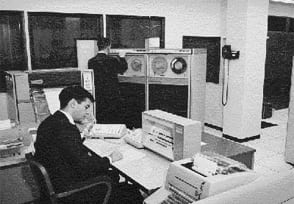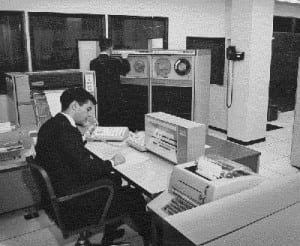
(Here in 1966, later it was the first host to connect to the Internet)
Rick Crandall at the console of SDS 940 Computer
Serial #2, September, 1966 at Comshare, Inc.
The control panel is the central control hub of the historic Scientific Data Systems 940 computer made in July of 1966. The SDS 940 was the first computer designed specifically for on-line computing. It was also the first host computer ever to be connected to the “Internet” in October 1969 at the Stanford Research Institute.
The 940’s basic operating system (i.e. the equivalent of Unix or Windows NT today) was created in 1966 as a collaboration of the U.C. Berkeley researchers, Rick Crandall of Comshare (Ann Arbor), Scientific Data Systems (Santa Monica) and Tymshare (Cupertino). Comshare continued the development into Commander I, its first commercial timesharing offering.
As quoted from “Where Wizards Stay up Late, The Origins of the Internet”1
“A month after the first IMP2 was installed at UCLA, IMP Number Two arrived at SRI right on schedule on October 1, 1969… The SRI guys loved their host computer, an SDS 940… a revolutionary time-sharing system first put together by a team at Berkeley… With both IMP’s now in place, the moment to test the actual two-node ARPA3 network had finally arrived.”
The test worked and the Internet was born. The 940 at SRI was serial #3 made by SDS. The one at Comshare was Serial #2. The ARPA network aimed at governmental and academic uses while Comshare and Tymshare opted for commercialized uses of the technology.
1. Katie Hafner and Matthew Lyon, Simon & Schuster, 1996: pp 149-152
2. Interface Message Processor, the computerized network switch for the internet, originally created by Bolt, Berenak & Newman
3. Advanced Research Projects Agency, the government agency who funded the early work on the Net.



